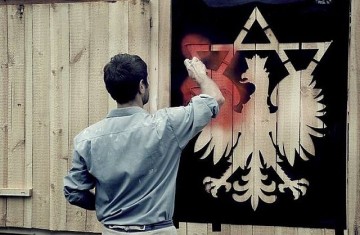While analysing the failures of her love life, Carrie Bradshaw asks herself: “Can I forgive, if I can’t forget?” I wouldn’t be mentioning the famous sex columnist from New York, if her words weren’t the perfect illustration of Polish-Jewish relations. The efforts of many are focused on fostering forgiveness, but they simultaneously encourage keeping the memory alive. It doesn’t matter what perspective you use to look at the issue, Poland and Israel just don’t click. Although they share a border on one of Wilhelm Sasnal’s paintings from 2000, the painted map depicts Israel taking Germany’s place. This exact painting was given as a farewell gift to Anda Rottenberg, when she was stepping down as the director of the Zachęta’s during a period marked with increased anti-Semitism. Sasnal’s painting also illustrates how seriously Polish-Jewish relations should be treated, despite the nations’ geographical separation – mostly due to shared historic burdens and the pervasiveness of hurtful stereotypes.
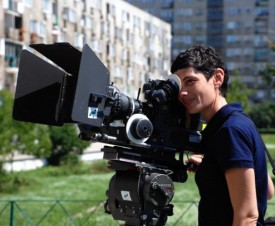 Yael Bartana, photo: Daniel MeirA decade after Rottenberg’s resignation, Israeli artist Yael Bartana is representing Poland at the prestigious Venice Biennale with her …and Europe Will Be Stunned trilogy, which she filmed in Warsaw. Nobody claimed that Bartana’s project was anti-Polish. Maybe the circles that were hostile to similar projects in the past finally realised that the statues of the King of Poland and the King of the Jews actually depict the same person.
Yael Bartana, photo: Daniel MeirA decade after Rottenberg’s resignation, Israeli artist Yael Bartana is representing Poland at the prestigious Venice Biennale with her …and Europe Will Be Stunned trilogy, which she filmed in Warsaw. Nobody claimed that Bartana’s project was anti-Polish. Maybe the circles that were hostile to similar projects in the past finally realised that the statues of the King of Poland and the King of the Jews actually depict the same person.
Stadium-tribune
It all started in 2007, when Bartana came to Warsaw to shoot her short film, Nightmares. Standing amongst the ruins of the 10th Anniversary Stadium in Warsaw, Sławomir Sierakowski, the editor of the Political Critique, heavily made-up to resemble a hardline communist from the 1950s, is making an impassioned speech. The speech, co-written by Sierakowski with Kinga Dunin, is a plea addressed to three million Jews, asking them to return to Poland. But the stadium stands empty. The three million Jews who where living in Poland before the war have either died in ghettos and death camps or have left the country after the war. The only thing left is an unspoken, lingering feeling of emptiness and guilt.
In reality, the stadium was empty because Nightmares was filmed just before the old construction was torn down to be replaced by the, nomen omen, National Stadium. Gone is the multilingual din of the Europa Bazaar. Gone is the place where traders from Africa, the Middle East, and Asia were trying to make a living. The Bazaar was like an ironic echo of the Youth Festival of 1955, when colourful, cosmopolitan crowds filled the Polish capital. Sierakowski’s speech, despite assurances of it not being a “plea of the defeated”, didn’t reach anyone. Why? Maybe because it was addressed to the wrong people. It seemed that there is nobody left to claim Ryfka’s quilt, which Sierakowski mentions and which seems to trouble the Polish conscience.
Museum-kibbutz
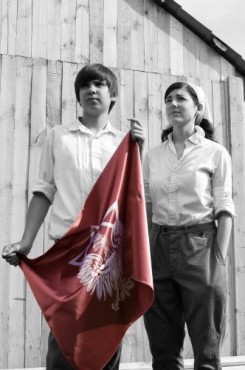 Yael Bartana, Wall and Tower, 2009
Yael Bartana, Wall and Tower, 2009
courtesy of Annet Gelink Gallery,
Amsterdam and Sommer Contemporary
Art, Tel Aviv,
photo: Magda Wunsche & Samel In 2009, a wooden kibbutz was built on the premises of the former Warsaw ghetto. It was patterned after kibbutzim erected in Palestine in the 1930s. Back then, the settlements had to be built in one night and meet certain requirements, including a guard tower and a high wall. The kibbutz was used as a set in Bartana’s next movie, Wall and Tower, in which Jews respond to Sierakowski’s appeal from Nightmares. The set became popular among Warsaw denizens so the kibbutz was opened to the public. Unfortunately, in Poland wooden huts, barbed wire, and guard towers are commonly associated with concentration camps rather than kibbutzim, so a big part the visitors was left confused.
The message Bartana was trying to convey with her work is clearly visible in Wall and Tower, which was supposed to imitate the pre-war Zionist propaganda rhetoric. The movie’s tone can easily be described as idyllic. The Jewish pioneers are happy, optimistic, see Poland as their new home, they learn the local language, everything goes smoothly, and when the day’s work is done, everyone gets to rest under an apple tree. It’s idyllic and completely alien at the same time, like a spaceship just landed in front of us.
Also, Wall and Tower marks the first appearance of the Jewish Renaissance Movement logo. The symbol is comprised of the White Eagle from the Polish coat of arms and a Star of David. In the movie, it is painted onto the kibbutz wall by none other than Wilhelm Sasnal. Sierakowski’s appeal from Nightmares, rather then recognised as a symbolic gesture, has been treated literally by the characters in Bartana’s political fiction.
After the shooting wrapped, the set was demolished and ground was broken for the Museum of the History of Polish Jews. By building her kibbutz, Bartana symbolically sanctioned the construction of seemingly exterritorial museum, but she also claimed it for her own ideas. The museum, erected in the exact place where Bartana’s kibbutz stood, becomes a tool of restoring a Jewish identity to Warsaw, just as the kibbutz was. But when Barack Obama visited the construction site during his short trip to Warsaw, the gesture was interpreted as a nod to American, rather than Polish Jews.
Hasta la vista, baby
Everything gets complicated in Assassination, the final installment in Bartana’s trilogy, shot in April of 2011. Sierakowski, the leader of the Jewish Renaissance Movement, is assassinated in the Zachęta Gallery, while standing in front of one of Bruno Schulz’s paintings. The scene is a reference to the deaths of two Polish heads of state – Gabriel Narutowicz and Lech Kaczyński.
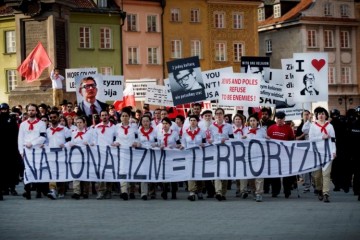 Yael Bartana, Assassination, 2011, photo: M. Kaliński
Yael Bartana, Assassination, 2011, photo: M. Kaliński
Assassination starts with Sierakowski lying in state at the Congress Hall in the Palace of Culture and Science in Warsaw. A big group of people is lining up to pay their last respects to the deceased and write in the condolence book. Later, we see a big gathering of the Jewish Renaissance Movement on Piłsudski Square, a cross between a funeral and a political rally. It’s not nearly emotional enough to be mourning, and the palpable pathos is reminiscent of a school assembly rather than authentic emotion.
During a small service at Sierakowski’s memorial, his widow, Dana Sierakowska mentions the circumstances of her husband’s death. Anda Rottenberg reminds us of the multicultural and multiethnic roots of modern Poland and modern Europe by bringing up Jan Zamoyski, the founder of Zamość. Two teenagers read aloud the Renaissance Movement’s manifest – it’s in English, so they mumble through it like they have a potato in their mouths. But out of the mouths of babes…
The only convincing speeches at the service are given by Alona Frankel, an Israeli writer born in Poland, and Yaron London, an Israeli journalist. It’s hard to disagree with Frankel, who demands that her Polish citizenship, which she had to give up when she left for Israel, be returned to her (even though she doesn’t plan on coming back to Poland). London contradicts the Movement’s main idea, claiming that Israel is the only home of the Jews and the Israeli Defense Forces the only guarantee that the Holocaust will never happen again. Finally, some concrete postulates and a clear position of the Movement is elucidated, replacing the lofty but ambiguous slogans like “We will be strong in our weakness” (which echoes a sentence from the New Testament: “My strength is made perfect in weakness”). The slogan is derived from Zionist rhetoric, as Israel used self-defense to justify building its military might.
Linoleum oblivion
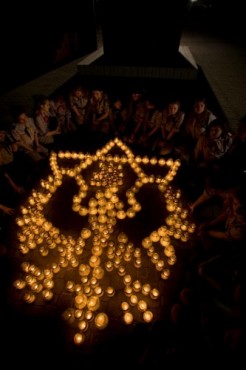 Yael Bartana, Assassination, 2011
Yael Bartana, Assassination, 2011
photo: M. KalińskiUnexpectedly, we start looking at things from the point of view of Ryfka, whose quilt was mentioned by Sierakowski in Nightmares. Her ghost wanders here and there (visible to us, but not the characters in the movie). She’s dressed in black, the indispensable suitcase held firmly in her hand, and suddenly she starts her own speech. The atmosphere gets so incredibly dense and sticky that it makes me want to hide under a chair. We hear the names of death camps mixed with terrible verses written by some two-bit poet. Where did the ease and the power of Dunin’s and Sierakowski’s words vanish to? We hear things about the “linoleum of oblivion” (what?), “weaving the torture of identity out of the threads of oblivion”, “the crypt of remembrance” or the “tomb of inexpressible grief” (quotes taken verbatim from the latest issue of Political Critique). Ryfka speaks in an equally enigmatic manner: “I listen to my own voice, my own voice, even though it sounds very mysterious to me, now more than ever. Is the voice, my voice, really speaking to me and about me?”.
Sierakowski’s memorial looks more like a caricature than anything else. Candles forming the logo of the Jewish Renaissance Movement are lit next to the memorial and people in the crowd can be seen holding signs with weird slogans, like “I’m sad” (written in Polish, Hebrew, and English). As a matter of fact, it all looks like some strange pastiche, but I’m afraid that it’s unintentional. Even Sierakowski himself, so convincing in Nightmares, here just looks like Woody Allen when he’s trying to play a serious character.
H(y/i)st(e/o)ric fantasy
Why would Europe be stunned? Because it’s less liberal than it thinks? You don’t really have to look very far to find proof of that, just check any newspaper.
Bartana’s work is similar to many other examples of historical fiction, in literature and in visual arts. In The Plot Against America, Philip Roth envisions an alternative history of World War II, where Charles Lindbergh becomes the president of the United States despite his anti-Semitic stance. The final pages of the novel reveal that Lindbergh was working for the Third Reich. We experience the American flavour of World War II anti-Semitism from the point of view of a small Jewish boy from Newark. But Roth gives us a happy ending – the alternative timeline becomes one with the “true” historic one.
The main difference between Bartana and Roth is that the former does not create historic fiction, but rather an alternative vision of the present. Unfortunately, this vision also comes “back on track”, and becomes “our” vision, replete with stereotypes about Poland, Jews, and Europe. In the companion book to the exhibition, Israeli writer and artist Avi Pitchon writes that Bartana provides only the framework, the name, and the founding myth for a process already underway, namely the devaluing of the Zionist idea among Israelis themselves and their emigration to Europe (although not necessarily to Poland). Israel “does not offer them the opportunity to fulfill their basic human needs”. In this case, Israeliness becomes an international phenomenon, exceeding the ideas of Zionism. The basis for this reborn society is participation in Europe’s history.
Did you eat?
Despite the hype around the trilogy and despite attempts at pushing fiction into reality, Bartana’s project is simultaneously an intervention concerning the future and an effort to magically undo the past. Not only undo the trauma of the Holocaust, but also the hellhole of public discourse we have in Poland (examples include the discussions surrounding Anda Rottenberg’s resignation or the Smoleńsk disaster). Maybe the idea of responding to Sierakowski’s plea from Nightmares and shooting subsequent installments of the trilogy took many people by surprise. Why do it? The expiation was complete.
But what was still needed was a sacrifice. In Poland, the social emancipation movement should coalesce around the death of Maxwell Itoya, a Nigerian shot by the police at the Bazaar, and not the fictitious assassination portrayed in Bartana’s work. Assassination is more about the traumatised Israelis, haunted by ghosts of the past, forever out of reach. Poland seems to be the ideal place to undo past traumas. And this parody of expansionist Zionism, whose success was based partly on the fear of anti-Semitism (and let’s face it, it’s not like that fear wasn’t justified), is supposed to be the instrument of that undoing.
This fear is perfectly illustrated by Woody Allen. It’s one of his strongest afflictions, only his hypochondria triumphs over that one. On one hand, Allen is able to construe a simple sentence like “Did you eat?” into “Did Jew eat?”, a remark reeking of anti-Semitism (Annie Hall); on the other, he justifies leaving a performance of Wagner’s opera saying that listening to Wagner makes him want to invade Poland (Manhattan Murder Mystery). It’s like he’s scared of getting infected by Wagner’s anti-Semitism (N.B.: playing Wagner in Israel is to this day considered a very controversial undertaking.) In Scoop, Allen sarcastically jests: “I was born into the Hebrew persuasion, but when I got older I converted to narcissism.”
Being a little particle in a giant universe isn’t all that funny
The creators of Assassination could have used a little of that kind of self-deprecation. Bartana retreats into kitsch, as if hit with a sudden jolt of fear. Her film becomes dangerously ambiguous and reeks of pessimism. Not because the Movement’s leader is assassinated (from a political standpoint, he’s more useful to the Movement dead than he ever was alive), but because the film clearly shows you cannot undo the nightmares of the past. Identity is once again built upon the victim’s sacrifice. Wasn’t Sierakowski’s speech supposed to replace the Israelis’ appeal to the Palestinians? Ultimately, we learn nothing new about Europe or Poles themselves. And it’s not like Poland is racism- or anti-Semitism-free, just visit any working sports stadium, you’ll see for yourself. All we have left is a political dream.
But in this dream, despite the assurances of the Movement’s founders that “there are no chosen peoples”, it’s the Jews – as a chosen people – who are supposed to liberate Europe from its xenophobia by taking upon themselves the suffering of Others (the pallbearers at Sierakowski’s funeral are of all races). In addition, when they finally feel that the Zionist idea is legitimate, they discover that they’re unwanted here. I don’t believe Ryfka when she says she’s “leaving”. If she is, then it’s probably to Israel, to haunt people there. “Leave the ghetto of collective nostalgia!”, to repeat the words of Communique No. 1 of the Intercity Anarchist Federation. Bartana proves that the ghost of the past will not stop haunting our dreams. And what’s worse, they will take on the form of a pathos-filled school assembly taking up our entire long break.
…and Europe Will Be Stunned, 54th Venice Biennale, open until November 23, 2011. Bartana’s trilogy will also be screened in the Zachęta Gallery in Warsaw until August 21, 2011.

